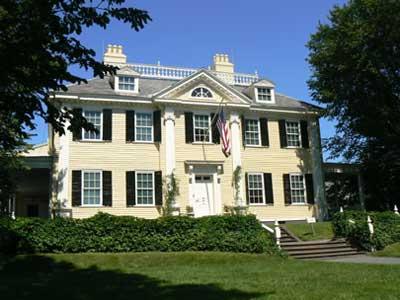Many park fans know that each NPS site is assigned a 4-letter designation for administrative purposes, and that abbreviation is also used as part of each park's website address. Yellowstone, for example, is "YELL." The NPS unit dubbed LONG now has a longer, and more descriptive, official name. Do you know where it's located?
The change involves the name of arguably one of the best-known figures in American history—George Washington. From July 1775 to April 1776, during the siege of Boston, General George Washington and his family lived in a house in Cambridge, Massachusetts, which also served as his headquarters during that period. The house was later the home of Henry Wadsworth Longfellow, a popular 19th-century poet and scholar.
“The house was the first major headquarters of the American Revolution and Washington’s second-longest held headquarters,” said site manager Jim Shea. “During this critical first year of the American Revolution the house became a center for diplomacy and strategy.”
The structure, built in 1759, was home to Longfellow and members of his family from 1837 through 1950. It was given to Henry Wadsworth Longfellow by his father-in-law Nathan Appleton as a wedding gift in 1843.
The poet’s family actively preserved the home, beginning as early as 1913, but it was not designated a part of the National Park Service until the poet’s descendants donated the home nearly 60 years later. It was named Longfellow National Historic Site—and is assigned the NPS administrative code LONG.
A park spokesperson notes, "On October 9, 1972, Congress passed legislation authorizing the acquisition by donation of the historic property. Based on the family’s own reasoning, Public Law 92-475 reiterated that the home be preserved 'for the benefit and inspiration of the people of the United States.' The legislation acknowledged Washington’s connection but officially gave the site only Longfellow’s name."
The new name, Longfellow House-Washington’s Headquarters National Historic Site, became official when President Barak Obama signed a bill that became Public Law111-333 on December 22, 2010.
So, why the name change after nearly 40 years?
“The site’s connection to George Washington had become obscured over time,” said superintendent Myra Harrison. “In the 19th century, popular memory of the Washington occupancy was fresh and vibrant. This redesignation will help restore our links with this important part of our past.”
Harrison and Shea agreed that the change will show a more robust connection to the Revolution. “This formal name change will further emphasize the importance of the house’s associations with both Henry W. Longfellow and George Washington as well as highlight the original intent of the donation of the historic property by the Longfellow family to the National Park Service nearly 40 years ago.”
Frances Appleton Wetherell, Longfellow’s great granddaughter, who resides in the Boston area, also expressed her delight with the official name change: “When I think about how much the Longfellow family treasured George Washington’s connections to their beloved home, I know how happy they would be that their two names will be forever linked at this historic house.”
The home remains intact to the period of the Longfellow family, including the many artifacts they collected related to Washington and the Revolution. A bust of Washington still stands inside the front door, serving as the unofficial greeter to visitors. Longfellow himself poeticized the former occupant of the home in “To a Child,” noting that “Once, within these walls… The Father of his Country, dwelt.”
David McCullough, author of 1776, two-time Pulitzer Prize winner and recipient of the Presidential Medal of Freedom, reacted with great satisfaction to the news: “The full historic importance of the grand old, yellow clapboard house on Brattle Street, Cambridge, is conveyed at last by its new official name.”
Though the name change is new, the staff at the site has already been focusing on Washington’s time there. Events organized along with their community partner the Friends of the Longfellow House include thematic house tours and an annual lecture about the Revolutionary history that took place in the house.
This coming year’s lecture, scheduled for March 17, will cover Washington’s intelligence efforts during the siege of Boston, identifying some of his operatives for the first time. The home will also have events and tours as part of the celebration of Washington’s birthday in February.
Although the gardens and grounds are open daily, and the site offers special events and programs for school groups during the year, public tours of the house itself are available from about June 1 through October. You'll find information to help plan a visit on the park website.




Add comment